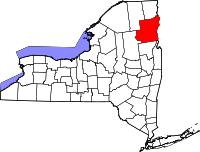Early Essex County History

Sometimes called “The Tyrol of America,” Essex is the most mountainous county in New York. With an area of 1,836 square miles, the second largest in the State, an average elevation of 3,000 feet, the highest in the State, it is a remarkable combination of lofty peaks, deep ravines, glorious lakes and streams which make it the mecca of thousands of lovers of nature’s grandeur. Mount Marcy, 5,467 feet, the highest summit in the Adirondacks, Lakes Placid, Schroon, as well as parts of Champlain and George, together with a hundred other bodies of water; Wilmington Notch, Rainbow Falls and Ausable Chasm, where the stream of that name forces its tempestuous way in a long series of falls and cascades through a ravine a hundred feet deep, all are within the boundaries of this county.
Essex lies on the western bank of Lake Champlain about a hundred miles from Albany. Much of it is located in the Adirondack Park. Its dimensions are fifty by forty miles. Its history may begin with the coming of Champlain with his companions and Indians in I609; but as a county starts on March 1, 1799 when it was formed from Clinton County. Permanent colonization was delayed by the wars between the English and the French, with the added difficulties brought about by the confliction of grants of land made by the two governments. Champlain had been given sovereignty over the territory as a reward of discovery; a patent under the date 1758 also covered this district.
With the passing of the French dominion came a proclamation by the King of England, October 7, 1763, empowering the colonial governors to issue grants within their domain. These covering the same lands already granted by the French, threw doubt on all the titles for land, and in the period of adjustment, many threw their properties on the market at prices not in accord with their values. William Gilliland shrewdly took advantage of these conditions, bought several thousand acres in Essex and Clinton counties, and upon them established the first planned colony, 1765, Willsborough. To the south near the outlet of Lake George, another New York merchant, Samuel Deall, was founding the town known as Ticonderoga. With the end of the Revolution, a current of emigration set in that speedily peopled the desirable lands. In 1790 Platt Rogers maintained a ferry at Basin Harbor and received great tracts of land. In 1792 Judge Hatch located at Brookfield, town of Essex. A small colony was at Westport; Elizabethtown already was started. In 1797 the present town of Schroon was founded, and even before this date, the better parts of Jay, Lewis, and Keene were occupied by settlers.
In 1799 came the organizing of the county with Elizabethtown as the seat of justice, and the territory divided embracing four towns-Crown Point, formed 1780; Elizabethtown, 1798; Willsborough formed 1788, both from Crown Point; and Jay from Willsborough in 1798.
The colonists at first produced only the things needful to themselves, agriculture being the main industry, but there soon followed the need for roads, saw and gristmills. These were gradually provided, and as early as 1801 plans were laid to begin iron making from the ores brought from the Vermont hills. For the first ten years little was known of the presence of iron in their own State. Anchors and boat irons were made in Willsborough in 1801; shortly, later W. D. Ross had a rolling mill on the Boquet; in 1809 Archibald McIntyre started the Elba Iron Works at West Elba. By 18Z5 the iron industry had grown to quite respectable proportions. Ore beds were opened in various parts of the county and metal working became, in later years, the principal manufacturing interest in Essex.
Meanwhile, since 1800, the lumber business had begun to be pursued on a large scale. Boats of size were sailing the lakes. The first steamboat plied the waters of Champlain in 181O. A canal had been projected and built between 1818 and 1823 connecting the lake with the Hudson. Railroads came much later, 1871, and these only paralleled the Lake Champlain shore.
The county seat of Essex was first located at the town of the same name, and from 1799 to 1807 the courts were held there. In the latter year a commission appointed by the Legislature designated Elizabethtown as the future shiretown. New buildings were erected at the great cost of $2,500 in 1811. These were destroyed by fire shortly after, were rebuilt and again burned, 1823, and again rebuilt in 1843. The repeated burning of the county buildings destroyed many valuable records. It also led to the passing of a law which still is in force, empowering the “Court of Common Pleas” to designate any place in town for the holding of court.


